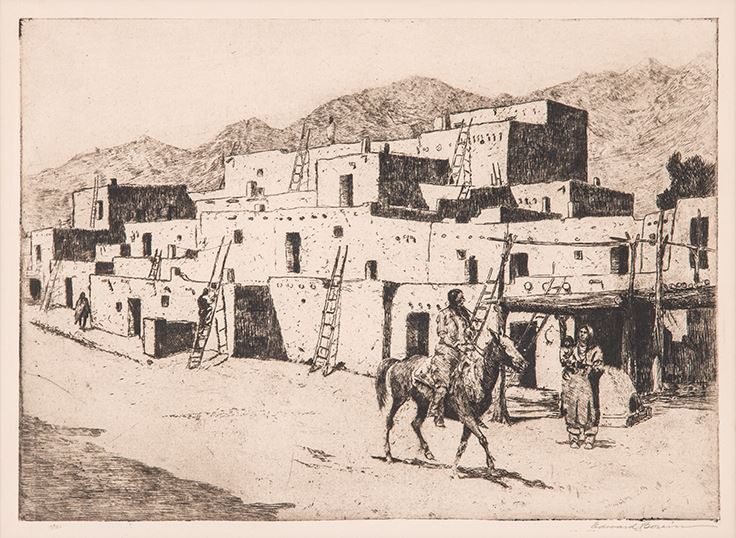
Western Artist, Edward Borein (1872-1945). "A Street in Taos" Dry Point Etching, Galvin Plate #231, #885-
$ 5,808.00
Western Artist
Edward Borein, " A Street in Taos"
884. Description: Western Artist, Edward Borein (1872-1945). “A Street in Taos”. Dry point etching. Galvin plate #231, second state. Signed in pencil in lower right margin.
Dimensions: 8 ½" x 11 7/8"
Condition: Very Good Condition.
Provenance: Notes: This piece has appeared in a number of exhibitions, including one in 2012 and one in 2014 at St. Mary's College Museum of Art, Moraga, CA. Provenance: Exhibition stickers on verso.
Details included: 1. Saint Mary's College Museum of Art, Moraga, CA. July 8-Sept 16, 2012. "The Nature of collecting: The Early 20th Century Fine Art Collection of Roger Epperson". 2. Saint Mary's College Museum of Art Moraga, CA Aug 10-Sept 21,2014 and Dec 7, 2014. "The Native American Collection of Roger Epperson" .
Epperson was an East Bay Regional Parks ranger with a passion for California's environment and a deep love of art. Over a nearly 30-year period, Epperson amassed a collection of more than 300 beautiful, museum-quality works of art, collected piece by piece from antique stores, galleries, garage sales and, later, online sources.
Epperson died in a kayak accident in Hawaii in 2008. A slope on Mount Diablo has recently been dedicated as "Roger Epperson Ridge."
------------
Additional Edward Brien Etchings can be found at:https://www.etsy.com/your/shops/CulturalPatina/sections/16492699
---------
Born in San Leandro, California, Edward Borein became one of the most popular artists of western scene painting, equally adept at ink drawing, watercolor, and etching.
He was raised in San Leandro, a western cow town, in a family where his father was a county politician. Edward had many childhood memories of herded cattle and their cowboys, which he began sketching at the age of five. He was educated in the Oakland, California schools, and at the age of 17 began working on a ranch near Oakland and then drifted and sketched as a working cowboy throughout the Southwest, Mexico, and Guatemala.
It was said that he practiced his art on anything he could find from bunkhouse walls to scraps of paper. At age 19, he enrolled at the San Francisco Art School, his only formal art training, and there he met Jimmy Swinnerton and Maynard Dixon who encouraged him in his art career.
The first person to purchase his work was Charles Lummis, editor of The Land and Sunshine magazine in California, and the two became life-long friends. Borein and Lucille Maxwell were married in the Lummis home. Borein, a typical westerner in dress and manner, also became close friends with Charles Russell, actor Will Rogers, and President Theodore Roosevelt. Borein often traveled north to visit Russell in Great Falls, Montana and to travel among Indian tribes.
In 1899, Borein visited Arizona while returning from Mexico. By 1902, he was a successful illustrator in San Francisco for the San Francisco Call, and in 1907 to enhance his illustration skills, went to New York to learn etching techniques. There he enrolled in the Art Students League and was a student of Child Hassam. In the theatre district, he opened a studio that became a gathering place for 'lonesome' westerners such as Charles Russell, Will Rogers, Olaf Seltzer and Oscar Borg. But Borein did not feel at home in New York, so he moved to Santa Barbara, California in 1921.
This was a final move. He and his wife built a Hopi-style home, and he taught at the Santa Barbara School of the Arts until his death, and also turned increasingly from oil to watercolor painting. "On occasion Borein would decorate place cards for dinners with small watercolor sketches of cowboys, vaqueros, Indians and Bucking horses". (Santa Fe Auction) From his studio, which again attracted many of his friends, he depicted Indians, cowboys, and California ranch life and was financially successful.
Source:
Edan Hughes, Artists in California, 1786-1940
Michael David Zellman, 300 Years of American Art
Santa Fe Art Auction catalogue, 10/2001
Note:
Edward Borein's birth date is often given as 1873. That date appears in many publications, however, I think now it is generally believed that the correct date is 1872. Harold Davidson uses the 1872 date, based on a birth notice in a California paper.
-------
View the other items in my shop: http://www.etsy.com/shop/CulturalPatina?ref=shopsection_shophome_leftnavDescription:






